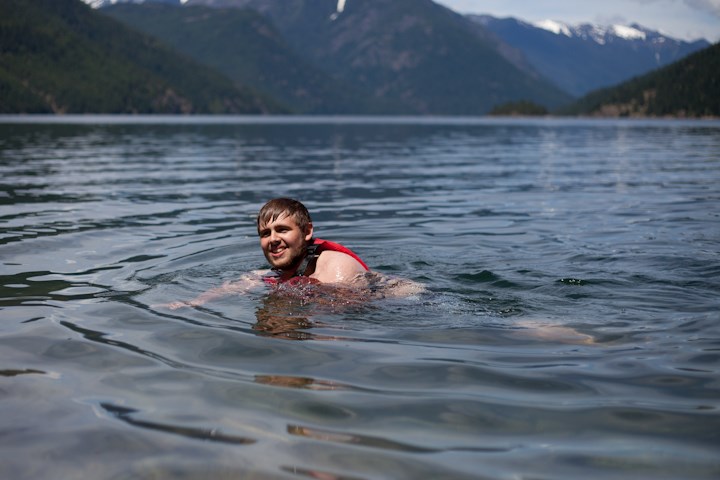Last updated: May 10, 2024
Article
Go for a Swim in a Park

NPS/Karlie Roland
Swimming in natural waters (e.g. streams, rivers, lakes, oceans) is very different from swimming in a swimming pool.
- Water currents can tire you out and sweep you away
- Distance across water is greater than it looks
- Cold water can shock your body and make it difficult to swim
- Water depth can suddenly change to above chin level
- Underwater hazard like trees and rocks can trap you and keep you from swimming back to shore
Preparation is key to bringing everyone home from a fun day in the water
- Find out if swimming is allowed in the park before you head out
- Check the “Plan Your Visit” section on the park’s website or contact the park to find out about water regulations and water safety
- Leave a trip plan with your travel details with a friend or family member
- Bring a friend so you are not swimming alone
Follow the swimming tips below for your adventure in a national park!
Wear a properly fitted, U.S. Coast Guard approved life jacket when swimming at all times. Rafts, inflatable swimming rings, and inflatable water wings are not a substitute for a life jacket, especially for children and inexperienced swimmers.
In the event of an emergency a life jacket can help you float while you wait for help.
Even strong, experienced swimmers can get caught in a current, become fatigued, or suffer an injury. It can take time for Search and Rescue teams to reach you depending on your location, water conditions, and weather forecast. A life jacket can save your life.
Some parks have life jacket loaner stations. You can borrow a life jacket for free and return it when you are done. Contact the park to find out if this is available.
Learn more about life jacket requirements for boating activities on our vessel safety page.
Swimming is more than strokes. Swimming lesson teach you water survival skills and help you develop comfort in the water.
Be realistic about your swimming abilities and your experience swimming in natural waters. Know your limits and the limits of everyone who is swimming with you.
Designate a “Water Watcher”. This is a person who is responsible for supervising children, inexperienced swimmers, and those who cannot swim.
Even when a lifeguard is present, children and inexperienced swimmers should wear a life jacket and be within arm’s reach of an adult at all times. A moment’s distraction could quickly lead to a drowning.
Depending on your group size, you may need to designate more than one Water Watcher.
Visit www.weather.gov to check the weather forecast the day of your trip. Visit the park’s website or contact the park to learn if there are any active water safety park alerts or weather closures that may impact your visit.
A warm sunny day can quickly turn into a thunderstorm with lightning, strong currents, and flash flooding. Pay attention to the sky around you for changing weather conditions and be prepared to return to shore.
Learn more about weather safety and how to be weather ready!
Water currents can be difficult to see. For example, rip currents in oceans and lakes or river currents can look calm on the surface but are moving fast underneath.
Water currents are stronger than they look. They can tire out and sweep away even strong, experienced swimmers. Even wading in shallow water can pull you off your feet. Stand far from moving water so that an accidental trip or slip on wet rocks will not cause you to fall into the current and be swept away.
If you are caught in a current:
-
Don’t fight the current
-
Swim parallel to shore if caught in a rip current
-
Swim across a strong river current to reach shore
Learn more about river current safety.
Tides are the rise and fall of sea levels. Oceans, estuaries, and their tributary streams are tidal. Tides reverse about every six hours.
High tide can cover up hazards like sandbars, seaweed, and rocks that you would be able to see during low tide. It could cut you off from shore if you swam to a rocky outcrop or sandbar during low tide. High tide can also flood caves that are accessible during low tide and cause you to become trapped.
Low tide means that you are swimming far from shore and if the tide changes, you may need to swim a long distance to get back.
Check tidal tables before swimming or adventuring down beaches, especially those with cliffs. Upon arrival, observe the water and take note of the tide. If trapped by an incoming tide, seek higher ground and call for help.
Plan and prepare for your trip with help from the NPS Trip Planning Guide and Junior Ranger Park Explorer. Learn more about your Health & Safety in national parks.
For more information weather and water safety, see the links below:
Learn more about weather safety and how to be weather ready.
Learn more about boating safety.
Learn more about the top 5 common water hazards and river and stream safety in parks.
